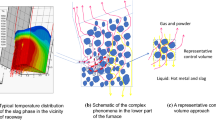Abstract
Steelwork is one of the main CO2 emitters due to three main off-gases of blast furnace gas, coke oven gas, and basic oxygen furnace gas. Many efforts are being made to reduce CO2 emissions by unit optimizing or by carbon capture and storage processes. In this paper, the simulation of blast furnace gas and coke oven gas recovery is investigated using Aspen HYSYS. For this purpose, a part of the blast furnace gas gases is mixed with the coke oven gas and injected into the Fischer–Tropsch reactor to produce liquid hydrocarbons. The process has been optimized by response surface methodology using Design Expert. The optimized simulation results showed that by mixing a portion of blast furnace gas and coke oven gas, the syngas was provided without fuel consumption in the reforming unit in both the reactor and utility system, while C5+ and C2-C4 were produced by 219Mbbl/day and 380Mbbl/day. At the same time, CO2 emissions decreased by 51%.
Graphical abstract











Similar content being viewed by others
Data availability
Enquiries about data availability should be directed to the authors.
References
Ahmadi M, Bahadori F (2022) CO2 utilization for the production of liquid hydrocarbons by coupled steam and dry reforming of bioethanol. Energy Sources Part A Recovery Util Environ Effects 44(3):7400–7412. https://doi.org/10.1080/15567036.2022.2112785
Aresta M, Dibenedetto A, Angelini A (2013) The changing paradigm in CO2 utilization. J CO2 Util 3:65–73
Bao B, El-Halwagi MM, Elbashir NO (2010) Simulation, integration, and economic analysis of gas-to-liquid processes. Fuel Process Tech 91:703–713
International Energy Agency (2007) Tracking industrial energy efficiency and CO2 emissions.
Forghani AA, Elekaei H, Rahimpour MR (2009) Enhancement of gasoline production in a novel hydrogen permselective membrane reactor in Fischer-Tropsch synthesis of GTL technology. Int J Hydrogen Energy 34:3965–3976
Hooey L, Tobiesen A, Johns J, Santos S (2013) Techno-economic study of an integrated steelworks equipped with oxygen blast furnace and CO2 capture. Energy Procedia 37:7139–7151
International Energy Agency (2020) CO2 Emissions from fuel combustion highlights, Excel Tables.
Iyuke SE, Daud WRW, Mohamad AB, Kadhum AAH, Fisa Z, Shariff AM (2000a) Application of Sn-activated carbon in pressure swing adsorption for purification of H2. Chem Eng Sci 55(20):4745–4755
Iyuke SE, Mohamad AB, Daud WRW, Kadhum AAH, Fisa Z, Shariff AM (2000b) Removal of CO from process gas with Sn–activated carbon in pressure swing adsorption. J Chem Technol Biotechnol 75(9):803–811
Kasuya F, Tsuji T (1991) High purity CO gas separation by pressure swing adsorption. Gas Sep Purif 5(4):242–246
Lyke SE, Moore RH (1981) Chemical production from industrial byproduct gases: final Report. US Dep. Energy.
Montazer-Rahmati M, Bargah-Soleimani MM (2001) Rate equations for the Fischer-Tropsch reaction on a promoted iron catalyst. Can J Chem Eng 79:800–804
Montgomery DC (2013) Design and analysis of experiments. 8th edN. John Wiley & Sons, Inc.
Myers RH, Montgomery DC, Anderson-Cook CM (2009) Response surface methodology: process and product optimization using designed experiments, 3rd edn. John Wiley & Sons Inc., New Jersey
Olah GA (2005) Beyond oil and gas: the methanol economy. Angew Chem Int 44(18):2636–2639
Quader MA, Ahmed S, Ghazilla RAR, Ahmed S, Dahari M (2015) A comprehensive review on energy efficient CO2 breakthrough technologies for sustainable green iron and steel manufacturing. Renew Sustain Energy Rev 50:594–614
Sofia D, Giuliano A, Barletta D (2013) Techno-economic assessment of co-gasification of coal-Petcoke and biomass in IGCC power plants. Chem Eng Trans 32:1231–1236
Uribe-Soto W, Portha J-F, Commenge J-M, Falk L (2017) A review of thermochemical processes and technologies to use steelworks off-gases. Renew Sustain Energy Rev 74:809–823
Xu C, Cang D (2013) A brief overview of low CO2 emission technologies for iron and steel making. J Iron Steel Res Int 17(3):1–7
Funding
The authors have not disclosed any funding.
Author information
Authors and Affiliations
Contributions
Mr. Javan involved in preparing figures. Dr. Rafiee involved in reviewing the manuscript. Dr. Bahadori involved in conceptualization, methodology, investigation, writing – review & editing and supervision of the manuscript.
Corresponding author
Ethics declarations
Conflict of interests
The authors declare no conflict of interests.
Additional information
Publisher's Note
Springer Nature remains neutral with regard to jurisdictional claims in published maps and institutional affiliations.
Supplementary Information
Below is the link to the electronic supplementary material.
Rights and permissions
Springer Nature or its licensor (e.g. a society or other partner) holds exclusive rights to this article under a publishing agreement with the author(s) or other rightsholder(s); author self-archiving of the accepted manuscript version of this article is solely governed by the terms of such publishing agreement and applicable law.
About this article
Cite this article
Javan-Bari, H., Rafiee, R. & Bahadori, F. Simulation and multi-objective optimization of liquid hydrocarbons production by coupling Blast Furnace Gas with Coke Oven Gas of steelwork. Clean Techn Environ Policy 25, 2777–2788 (2023). https://doi.org/10.1007/s10098-023-02530-2
Received:
Accepted:
Published:
Issue Date:
DOI: https://doi.org/10.1007/s10098-023-02530-2




